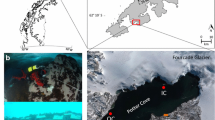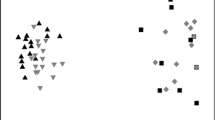Summary
-
1.
Aspects of colonization by freshwater invertebrates on artificial substrata (macrophyte models) placed in the benthos of a eutrophic lake were studied.
-
2.
Colonization was rapid, with equilibrium occuring at about 35 days. The colonization rate curve decreased with time but extinction rate remained constant.
-
3.
Predators formed 22–32% of the fauna at equilibrium.
-
4.
Area and distance accounted for 92% of the variation in species richness; 69% of the variation was due to area alone.
-
5.
The faunal coefficients z were higher than expected and may be due to competitive interactions in simple habitats.
Similar content being viewed by others
References
Brown, J.H.: Mammals on mountaintops: non-equilibrium insular biogeography. Am. Nat. 105, 467–478 (1971)
Brown, J.H., Kodric-Brown, A.: Turnover rates in insular biogeography: effect of immigration on extinction. Ecology 58, 445–449 (1977)
Cairns, J., Dahlberg, M.L., Dickson, K.L., Smith, N., Waller, W.T.: The relationship of fresh-water protozoan communities to the MacArthur-Wilson equilibrium model. Am. Nat. 103, 439–454 (1969)
Crowell, K.L.: Experimental zoogeography: Introductions of mice to small islands. Am. Nat. 107, 535–558 (1973)
Diamond, J.M.: Avifaunal equilibrium and species turnover rates on the Channel Islands of California. Proc. Nat. Acad. Sci. (Wash.) 64, 57–63 (1969)
Diamond, J.M.: Comparison of faunal equilibrium turnover rates on a tropical and a temperate island. Proc. Nat. Acad. Sci. (Wash.) 68, 2742–2745 (1971)
Diçkson, K.L., Cairns, J.: The relationship of fresh-water macro-invertebrate communities collected by floating artificial substrates to the MacArthur-Wilson equilibrium model. Am. Midl. Nat. 88, 68–75 (1972)
Heatwole, H., Levins, R.: Trophic structure stability and faunal change during recolonization. Ecology 53, 531–534 (1972)
Lack, D.: Island Birds. Oxford: Blackwells 1976
MacArthur, R.H., Wilson, E.O.: An equilibrium theory of insular zoogeography. Evolution 17, 373–387 (1963)
MacArthur R.H., Wilson, E.O.: The theory of island biogeography. Princeton, N.J.: Princeton Univ. Press 1967
Mason, C.F.: Populations and production of benthic animals in two contrasting shallow lakes in Norfolk. J. Anim. Ecol. 46, 147–172 (1977)
Mason, C.F., Bryant, R.J.: The structure and diversity of the animal communities in a broadland reedswamp. J. Zool. (Lond.) 172, 289–302 (1974)
Mason, C.F., Bryant, R.J.: Changes in the ecology of the Norfolk Broads. Freshwat. Biol. 5, 257–270 (1975)
May, R.M.: Patterns of species abundance and diversity. In: Ecology and evolution of communities M.L. Cody, J.M. Diamond (eds.), pp. 81–120. Cambridge-London: Harvard University Press 1975
Opler, P.A.: Oaks as evolutionary islands for leaf-mining insects. Am. Sci. 62, 67–73 (1974)
Patrick, R.: The effect of invasion rate, species pool, and size of area on the structure of the diatom community. Proc. Nat. Acad. Sci. (Wash.) 58, 1335–1342 (1967)
Schoener, A.: Colonization curves for planar marine islands. Ecology 55, 818–827 (1974a)
Schoener, A.: Experimental zoogeography: colonization of marine miniislands. Am. Nat. 108, 715–738 (1974b)
Seifert, R.P.: Clumps of Heliconia inflorescences as ecological islands. Ecology 56, 1416–1422 (1975)
Simberloff, D.S.: Experimental zoogeography of islands. A model for insular colonization. Ecology 50, 296–314 (1969)
Simberloff, D.S.: Equilibrium theory of island biogeography and ecology. An. Rev. Ecol. Syst. 5, 161–182 (1974)
Simberloff, D.S.: Experimental zoogeography of islands: effects of island size. Ecology 57, 629–648 (1976)
Simberloff, D.S., Wilson, E.O.: Experimental zoogeography of islands: The colonization of empty islands. Ecology 50, 278–296 (1969)
Simberloff, D.S., Wilson, E.O.: Experimental zoogeography of islands: A two year record of colonization. Ecology 51, 934–937 (1970)
Strong, D.R.: Nonasymptotic species richness models and the insects of British trees. Proc. Nat. Acad. Sci. (Wash.) 71, 2766–2769 (1974)
Ulfstrand, S., Nilsson, L.M., Stergar, A.: Composition and diversity of benthic species collectives colonizing implanted substrates in a south Swedish stream. Ent. Scand. 5, 115–122 (1974)
Wilson, E.O., Simberloff, D.S.: Experimental zoogeography of islands: Defaunation and monitoring techniques. Ecology 50, 267–278 (1969)
Wortley, J.S.: The role of macrophytes in the ecology of gastropods and other invertebrates in the Norfolk Broads. Unpublished Ph.D. thesis, University of East Anglia (1974)
Author information
Authors and Affiliations
Rights and permissions
About this article
Cite this article
Mason, C.F. Artificial oases in a lacustrine desert. Oecologia 36, 93–102 (1978). https://doi.org/10.1007/BF00344574
Received:
Issue Date:
DOI: https://doi.org/10.1007/BF00344574




